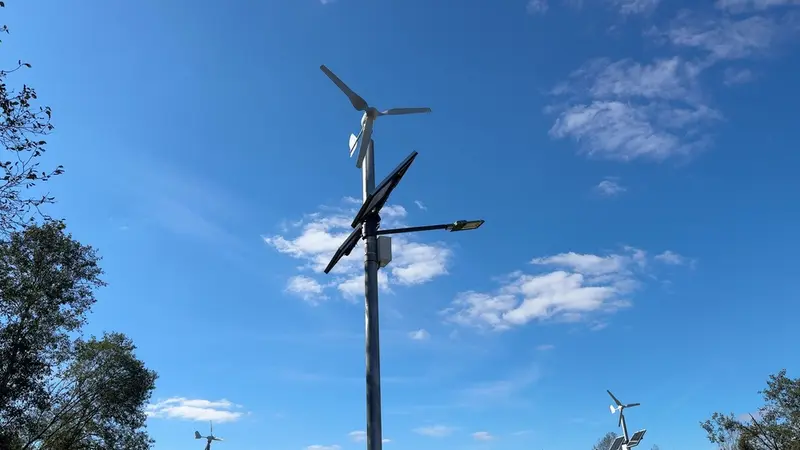When the wind picks up, most people expect wind turbines to spin faster and produce more electricity. But what many don’t realize is that during extremely strong winds, turbines actually stop. This process, known as wind turbine shutdown, is a key safety feature designed to protect both the machine and the environment around it. Learn more about the technology behind Elege Wind Turbine systems and their safety mechanisms.
What Is a Wind Turbine Shutdown?
A wind turbine shutdown is an automatic safety process that stops the turbine from operating when wind speeds exceed a specific limit. This threshold is called the cut-out speed, usually between 25 and 28 meters per second (about 90–100 km/h). When winds reach this level, the control system immediately triggers a shutdown sequence — rotating the blades out of the wind (pitch control) and locking the rotor in place. Once conditions become safe again, the turbine restarts automatically.
Why Do Turbines Stop During Strong Winds?
Although it may seem counterintuitive, stopping the turbine in high winds prevents catastrophic damage. There are three main reasons behind this:
- Mechanical Stress: High winds create immense pressure on blades, bearings, and shafts. Continuous operation could cause cracks or fatigue failure.
- Electrical Overload: The generator has a power limit. Beyond the rated wind speed, the turbine can’t safely convert additional energy without overheating.
- Structural Safety: To ensure the stability of the tower and foundation, the turbine must reduce mechanical loads during storms or gusty conditions.
In short, shutdown means protection, not failure. If you want to know how to keep turbines running efficiently, check out our guide on wind turbine maintenance.
Understanding Cut-In, Rated, and Cut-Out Speeds
To better understand wind turbine shutdown, it’s important to know the three critical wind speed thresholds:
| Operation Phase | Wind Speed Range | Turbine Status |
|---|---|---|
| Cut-in speed | 3–4 m/s | Starts generating power |
| Rated speed | 12–15 m/s | Produces maximum output |
| Cut-out speed | 25 m/s and above | Automatic shutdown for safety |
How Modern Turbines Manage High Winds
Modern turbines are equipped with advanced control systems that continuously monitor weather data and mechanical conditions. Key technologies include:
- Pitch Control System: Adjusts the blade angle to reduce wind pressure.
- Yaw Control System: Rotates the nacelle to align or misalign with wind direction for safety.
- Braking System: Uses aerodynamic or mechanical brakes to stop rotation quickly.
- SCADA Monitoring: Supervisory Control and Data Acquisition ensures smooth shutdown and restart operations.
Together, these systems make wind turbine shutdowns smooth, automatic, and completely safe. You can see similar systems in hybrid solutions like our wind and solar hybrid system.
What Happens After a Shutdown?
Once the storm passes and wind speeds drop below the safety threshold, the turbine’s control system performs several checks — including temperature, vibration, and mechanical stability. If all parameters are normal, it automatically restarts, resuming clean energy production without human intervention.
This self-regulating ability ensures high uptime and long equipment lifespan — two critical metrics for wind farm operators. For small-scale users, our small wind generator models offer similar protection features on a residential scale.
Common Misconceptions About Wind Turbine Shutdown
Myth 1: “When turbines stop, they’re broken.”
➡️ False. Shutdowns are planned and automatic safety actions.
Myth 2: “High winds mean more power.”
➡️ Only up to a point. Beyond the rated speed, excess wind doesn’t increase output — it risks damaging the system.
Myth 3: “Manual control is needed to stop them.”
➡️ Modern turbines shut down autonomously using onboard sensors and software.
The Role of Shutdown in Wind Farm Efficiency
While a shutdown means temporary downtime, it’s crucial for long-term reliability. Studies show that proper use of shutdown and restart mechanisms can extend turbine lifespan by 20–30%. Furthermore, this safety practice minimizes maintenance costs and ensures consistent energy output across changing seasons.
The wind turbine shutdown process is a vital part of modern wind energy systems. By automatically stopping during extreme winds, turbines protect themselves, reduce maintenance needs, and ensure years of reliable performance. So next time you see wind turbines standing still on a stormy day, remember — they’re not broken. They’re smartly protecting the planet’s clean energy future. Explore more innovations from Elege Wind Turbine today.

